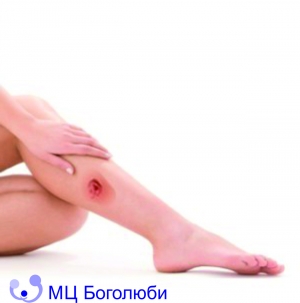Skin ulcers– are tissue defects that can affect both the superficial, epidermal layers and the deep ones - the dermis and hypodermis, and have a limited tendency to spontaneous healing.
Causes of leg ulcers
The possible causes of ulcers are multiple, although the palm in this case clearly belongs to venous vascular disorders. Let us turn a little to anatomy. From the school, we remember that in the veins there are valves that, under physiological conditions, prevent the backward flow of blood down. Thus, they help in regulating blood dynamics.
The most common cause of venous insufficiency of the lower extremities is a change in valve capacity. Valves are not able to guarantee proper blood circulation, and blood builds up in the veins. There is a situation of venous insufficiency, characterized by visible dilatations of the (venous vessels varicose veins).
In the long term, the accumulation of blood in the veins leads to an increase in venous pressure, which can become chronic and is defined as chronic venous hypertension.
Venous insufficiency resulting from chronic venous hypertension is a major risk factor and a leading cause of leg ulcers (more than 90% of cases). With venous insufficiency, the walls of the vessels are damaged, and blood flows outside the veins into the surrounding tissue.
Blood accumulates there, compresses tissues, damage to which is an obstacle to oxygen diffusion. In short, all of the above leads to the formation of venous ulcerative skin lesions. Another risk factor may be a violation of arterial circulation, which leads to the formation of arterial ulcers.
Among the leading causes of changes in arterial circulation are: atherosclerosis, diabetic angiopathy, hypertension, acute ischemia, or sudden blockage of blood supply caused by embolism. Other risk factors for ulcers on the skin of the legs are injuries, pressure sores, infections, autoimmune diseases, pharmacological preparations, tumor conditions, neurological diseases that lead to damage to peripheral nerves.
Are ulcers contagious?
Regarding the infectiousness of ulcers, it should be said that they are infectious only when they are caused by infectious diseases that are not treated properly.
Symptoms and diagnosis of leg ulcers
The presence of an ulcer can be painful or asymptomatic, depending on its nature and the presence of complications.
If we are dealing with an ulcer provoked by venous insufficiency, then the most common place for its localization is the inner surface of the ankle. Its shape varies from round or oval to serpentine. The lesion area and depth vary. The surface of the ulcer may contain purulent exudate. The presence of pink granulation tissue indicates a recovery process. Around a venous ulcer, one degree or another of edema is often present.
An arterial ulcer is usually small, rounded, contains necrotic tissue and is surrounded by thin, shiny skin. With hemorrhagic vasculitis, an ulcer is preceded by violet skin lesions (hemorrhagic spots), papules, nodules.
Clinical signs indicating a peptic ulcer infection: purulent exudate, pain, swelling, redness, local temperature increase. If these symptoms are present, a smear should be done to detect a bacterium or fungus. If vasculitis, autoimmune or tumor diseases are suspected, a small amount of tissue should be removed for histology.
Treatment and prevention of foot ulcers
The treatment of ulcers is based on the correction of the causative factor. Arterial and diabetes ulcers require angioplasty. With infectious ulcers, antibiotics are prescribed, with medicinal ones, they replace the active ingredient of the drug.
Autoimmune lesions need anti-inflammatory therapy. In case of venous ulcers, an elastic compressive dressing is recommended, which contributes to the outflow of blood up. Surgical intervention in case of varicose veins is also indicated. Vascular surgeons of MC “Bogolyuby” have extensive experience in conducting such operations. If you have a similar problem, you should immediately seek medical help. Prevention of ulcers is to prevent the underlying disease that causes them. And surgical treatment of venous varicose veins should be considered an important preventive measure. Treatment and prevention of leg ulcers The treatment of ulcers is based on the correction of the causative factor. Arterial and diabetes ulcers require angioplasty. With infectious ulcers, antibiotics are prescribed, with medicinal ones, they replace the active ingredient of the drug. Autoimmune lesions need anti-inflammatory therapy. In case of venous ulcers, an elastic compressive dressing is recommended, which contributes to the outflow of blood up. Surgical intervention in case of varicose veins is also indicated. Vascular surgeons of Bogoliuby MC have extensive experience in conducting such operations. If you have a similar problem, you should immediately seek medical help.
Prevention of ulcers is to prevent the underlying disease that causes them. And surgical treatment of venous varicose veins should be considered an important preventive measure.
















